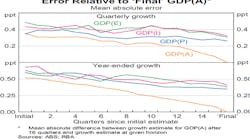Various economic indicators point to a strong 2014, according to the latest Logistics Market Snapshot, from the Georgia Center of Innovation. Tops among these are the following:
- Domestic transportation infrastructure is expected to grow to $135.8 billion this year, a 5% increase over 2013.
- More than 1.6 million TEUs of new ocean freight capacity are scheduled for delivery in 2014, possibly making 2014 a record-breaking year for capacity.
- U.S. auto sales in 2013 rose 7.6% over the previous year to 15.6 million autos. Ford's U.S. sales totaled about 2.5 million vehicles, accounting for a 10.8% increase, the largest of any other automaker in 2013. Nissan and Chrysler increased sales more than 9% while sales for Toyota and General Motors rose 7.4% and 7.3%, respectively. U.S. auto sales are expected to rise to 16.5 million vehicles in 2014.
- Intermodal rail traffic in December 2013 was 8% higher than in December 2012. Intermodal loadings have experienced year-over-year gains for 48 straight months, and for all of 2013, U.S. rail intermodal volume totaled a record-breaking 12.8 million containers and trailers, up 4.6% over 2012.
- More than 1.6 million TEUs of new capacity are scheduled for delivery in the upcoming year, possibly making 2014 a record-breaking year for capacity.
- The U.S. trade deficit decreased by 12.9% in November to $34.3 billion, the lowest trade deficit since October 2009.
Other highlights from this report:
Transportation Indexes:
• Dow Jones Transportation index rose 4.1% during the month of December. (Stock performance of twenty large, well-known U.S. companies in the transportation industry, average of December 10th thru January 10th)
• NASDAQ Transportation Index increased 6.6% in December. (Averaged share weights of NASDAQ-listed companies classified as transportation companies, average of December 10th thru January 10th)
• The December shipments index fell 6.2% over the previous month and fell 3.2% year-over-year. The December expenditures index fell 5.4% for the month, and increased 1.0% year-over-year. (Source: Cass Information Systems | Cassinfo.com) (Based upon transportation dollars and shipments of Cass clients comprised of over 400 shipping companies)
Rail:
• Railroad bulk carload freight in December 2013 fell 0.3% from November 2013. Freight traffic in December fell 0.9% from December 2012. Carloads excluding coal increased 2.1% over the previous year. (Source: AAR.org) (Report includes rail car-loadings by 19 different major commodity categories as well as intermodal units)
• Intermodal rail traffic in December 2013 was 8% higher than in December 2012, and rose 0.6% from November 2013. Intermodal loadings have experienced year-over-year gains for 48 straight months. For all of 2013, U.S. rail intermodal volume totaled a record 12,831,692 containers and trailers, up 4.6% over 2012. (Source: AAR.org) (Report includes rail car-loadings by 19 different major commodity categories as well as intermodal units)
Trucking:
• The ATA’s seasonally adjusted cargo index rose 2.7% in November. The for-hire truck tonnage index rose 5.8% from November 2012. (Source: American Trucking Association | Trucking.org)
• The spot market for truckload freight in December rose 11% compared to the previous month, and was 49% higher year-over-year. Truck capacity fell 17% for the month, and was down 2.3% year-over-year. (Source: DAT Trendlines | www.dat.com)
Air:
• Global air freight traffic in November increased 6.1% from one year ago, and rose 2.5% over the previous month. North American air freight in November rose 2.5% year-over-year. (Source: IATA.org) (Global air freight covers international and domestic scheduled air traffic.)
• International airfreight volumes will grow 17% over the next five years. By 2017, the five largest international freight markets will be the U.S., China, Germany, Hong Kong, and the UAE. The U.S. and China are likely to add more than 1 million additional tons each over the forecast period; as a result, China is expected to replace Germany as the second largest airfreight market in 2017. (Source: IATA.org)
Ocean Freight:
• Import shipment volume at U.S. ports totaled 1.64 million TEUs in September. U.S. vessel imports increased 2% from the previous month and rose 7% year-over-year. (Source: Zepol Corporation | zepol.com)
• Import volume through major U.S. container ports is expected to increase 1.8% in December. In October, the latest month for which numbers are available, U.S. container ports handled 1.43 million TEUs, a 0.4% decrease over the previous month and a 6.4% increase over the same month last year. Total U.S. containerized imports are expected to increase 2.3% in 2013. (Source: NRF/Hackett Associates)
Warehousing:
• The U.S. average industrial vacancy rate was 8.36% during Q3 2013, down from 8.65% in the previous quarter. (Source: Colliers International)
• In Q3 2013, warehouse and distribution rental rates in the U.S. averaged $4.79 per square foot, down from $4.81/SF in the previous quarter. (Source: Colliers International)
Employment
• The unemployment rate in America decreased to 6.7% in December 2013 as there were 74,000 net new jobs, the fewest in three years. About 347,000 people left the labor force during the month. The labor force participation rate fell 0.2 percentage points to 62.8% in December. (Source: US DOL)
• The trucking industry added 100 jobs in December after posting a gain of 8,300 in November. The trucking workforce increased 1.8% over the previous year. (Source: U.S. Bureau of Labor Statistics)
Economic Indicators:
• The Consumer Confidence Index increased to 78.1 in December 2013, up 6.1 points from the previous month. (Source: The Conference Board) (The consumer confidence index is based on a monthly survey of 5,000 U.S. household. It is designed to gauge the financial health, spending power, and confidence of the average U.S. consumer.)
• The Leading Economic Index for the U.S. increased 0.8% in November to 98.3 (2004=100), following a 0.1% increase in October and a 1.0% increase in September. (Source: Conference Board) (The LEI is a composite of 10 economic indicators that together create an analytic system designed to signal peaks and troughs in the business cycle. The LEI reveals patterns in economic data in a clearer and more convincing manner than any individual component alone.)



